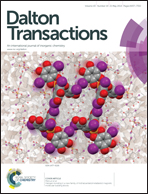Versatile coordination modes of bis[5-(2-pyridine-2-yl)-1,2,4-triazole-3-yl]alkanes in Cu(ii) complexes†
Abstract
Nine new mononuclear and polynuclear Cu(II) complexes [Cu(H2L2)Cl]Cl·3H2O (1), [Cu(H2L3)Cl]Cl·H2O (2), [Cu(H2L4)Cl]Cl·2.5H2O (3), [Cu3(μ3-L1)2(H2O)3](ClO4)2·H2O (4), [Cu4(μ-HL1)4](ClO4)8·CH3OH·5H2O (5), [Cu2(HL3)2](ClO4)2·2H2O (6a), [Cu2(μ-HL3)2](ClO4)2·H2O (6b), [Cu2(μ-HL3)(L3)Cu(teta)](ClO4)3·2H2O (7) and [Cu2(H2L3)2(ox)](ClO4)2·2H2O·2MeOH (8) containing [5-(2-pyridine-2-yl)-1,2,4-triazole-3-yl]alkanes (H2Ln, n = 1–4) in combination with other ligands, such as chlorido, aqua, triethylenetetramine (teta) and/or oxalato (ox2−), were synthesized and characterized by various techniques such as elemental analysis, FTIR, NMR and UV-Vis spectroscopy. X-ray structures of H2L3 and H2L4 as well as complexes 1–8 were determined. The X-ray structures revealed that relatively small composition and structural changes in the H2Ln ligands have a substantial impact on the coordination geometries of the complexes themselves as well as on their resulting magnetic properties. It has been found that the geometries of the complexes vary from square-pyramidal to trigonal-bipyramidal (with τ ranging from 0.00 to 0.96) and, moreover, that the trigonal bipyramidal geometry becomes more preferable with the increase in the length of the polymethylene chain within the corresponding H2Ln ligand. The magnetic properties of the polynuclear compounds 4, 5, 6, 7 and 8 were analysed using the spin Hamiltonian formalism, which revealed the presence of antiferromagnetic exchange in the polynuclear systems mediated by the title ligands. The significant effect of the geometric parameters on the Cu⋯Cu exchange interactions in the polynuclear complexes is discussed.
![Graphical abstract: Versatile coordination modes of bis[5-(2-pyridine-2-yl)-1,2,4-triazole-3-yl]alkanes in Cu(ii) complexes](/en/Image/Get?imageInfo.ImageType=GA&imageInfo.ImageIdentifier.ManuscriptID=C4DT00462K&imageInfo.ImageIdentifier.Year=2014)

 Please wait while we load your content...
Please wait while we load your content...